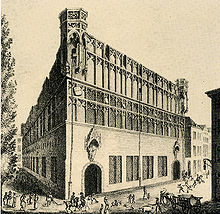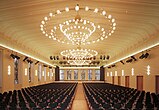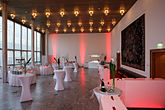Gürzenich
The Gürzenich is a festival hall in the center of Cologne's old town . It is named after the von Gürzenich patrician family , on whose property the secular building was built in the 15th century. The building complex has been used for concerts, congresses, social and cultural events since the beginning of the 19th century.
history


The hall building of the Gürzenich was built between 1441 and 1447 as a late Gothic ballroom building for 80,000 guilders . The builder is Johann von Bueren, who is known in Cologne in 1438 as a “ stonemason ” and since 1443 as a foreman “our heren vamme raede” (“our gentlemen from the council”). It is a two-aisled building with twin roofs and roof houses on hip and gable roof surfaces using Drachenfels stone .
The stones for the construction of the Gürzenich come from a quarry on the Drachenfels in the Siebengebirge. There the trachyte was dismantled and transported to Cologne by ship on the Rhine.
From the beginning, the building had the function of a municipal festival house (dance house) for a wide variety of events: On the one hand, the guests of honor of the city of Cologne were received in the ballroom, on the other hand, the premises were made available to nobles and "high" citizens for public and private celebrations. In 1474 Emperor Friedrich III invited to lavish receptions . and in 1486 the Roman German king and later Emperor Maximilian I , who here in 1505 a Reichstag held. Emperor Charles V also came to Cologne in 1520 after his coronation in Aachen . On the occasion of the Elector's Day in 1531, the Gürzenichsaal offered a magnificent picture for the last time for almost three centuries, because with the dwindling size of the imperial city of Cologne, the Gürzenich festivities also came to an end.
From around 1645 the building was temporarily used as a department store . On February 29, 1788, the Cologne banker Abraham Schaaffhausen was appointed commissioner of the department store. When the medieval festival house tradition was revived in the 20s of the 19th century, the Gürzenich regained its status as the most important Cologne event address. Carnival events were already among the most popular festivals back then : a year before the “ Cologne Carnival Festival Committee ” was founded, masked balls were danced in the Gürzenichsaal in 1822 . On May 6, 1849, Karl Marx proclaimed his “ Communist Party Manifesto ” in the overcrowded hall ; On May 8, an assembly of 500 representatives from Rhenish cities in the Gürzenich approved the constitution adopted by the Frankfurt National Assembly .
From 1857 until the completion of the Cologne Philharmonic in 1986, the Cölner Concert-Gesellschaft held its concert series in Gürzenich. This gave rise to the Gürzenich Concerts, which were later regularly held, as well as the Gürzenich Choir and the Gürzenich Orchestra . Among other things, Johannes Brahms ' Concerto for Violin, Violoncello and Orchestra (on October 18, 1887), Richard Strauss ' Till Eulenspiegel's Funny Pranks (November 5, 1895) and Don Quixote (March 8, 1898) as well as Gustav Mahler's Symphony No. 5 (October 18, 1904) premiered .
Because of the increasing cultural use, more space had to be created for events: In November 1851, a building plan was presented that also provided for the purchase of the “Herren-Brauhaus” (Martinstrasse 33) between Gürzenich and St. Alban's Church , in order to build a new building there to build and to connect with the Gürzenich. Between April 1855 and November 1857, the building was given an elaborate, stylistically adapted extension in the neo-Gothic style with a large staircase and the "Isabellensaal" from the city architect Julius Carl Raschdorff . The late Gothic hall had to give way to a three-aisled historicist ballroom, which was completed in 1885.
In 1881, the city council decided to preserve the historical procession on Cologne's city history, which had taken place at the end of the Cologne cathedral building in October 1880, as a mural with a total length of 53 meters in Gürzenich for posterity. The painters Wilhelm Beckmann , Fritz Roeber , Ernst Roeber , Albert Baur , Wilhelm Camphausen and Adolf Schmitz created the drafts and painted the ballroom with the 53 meter long frieze. On October 18, 1875, after a renovation on the ground floor, the Cologne Stock Exchange moved in; it stayed there until 1922. In 1928 the Catholic Workers' International was founded here, a forerunner of the Christian Democratic workforce .
The house was almost completely destroyed in the Second World War and rebuilt between 1952 and 1955 under the direction of the architect Rudolf Schwarz ; the inauguration took place on October 2, 1955. The extension and the interior design in the style of that time were carried out according to plans by Karl Band and Rudolf Schwarz. Since then, the Gürzenich and the neighboring church ruins of St. Alban have formed an inseparable unit. The Cologne triumvirate has been proclaimed in the Gürzenich since January 16, 1959 .
In 1986 the Gürzenich Orchestra moved to the Cologne Philharmonic , creating new uses for the building. KölnKongress GmbH was founded as the new operator in 1994 , in which the City of Cologne holds 51% and Koelnmesse 49%. A comprehensive modernization and restoration took place from 1996 to 1997, in particular the technical equipment was brought up to date and a glass external elevator was installed. This was done with extensive preservation and conservation treatment of the listed building fabric. In September 1997 he was solemnly called the “4th Gürzenich ”reopened. In June 1999, the Gürzenich became known worldwide as the meeting place for the G8 World Economic Summit .
Until December 2002, a pair of intercity trains was called Gürzenich . (IC 704/705 Cologne - Hamburg-Altona)
Todays use
The Gürzenich became known nationwide as the venue for meetings of the Cologne carnival associations . There are five rooms with a maximum of 1,338 seats. The Gürzenich Orchestra and the Gürzenich Choir are also known beyond the city limits.
The Gürzenich is known throughout Germany for television broadcasts by the WDR , which records a carnival session from the large ballroom, which is organized every year by the “Gemeinnützige Gesellschaft des Kölner Karnevals mbH”. In addition, a large number of other carnival events such as the prince proclamation take place.
In addition to these events , the Gürzenich is used for official receptions, large celebrations and social and cultural events, congresses as well as smaller stock exchanges and exhibitions: For example, the EU summit and the world economic summit ( G8 ) held their conferences here on June 3rd and 4th, 1999 .
On average, around 250 congresses, conferences, meetings, exhibitions, markets, concerts, carnival and social events take place here each year, which together attract around 170,000 visitors.
Rooms and capacities
Marsiliussaal , named after a Roman " captain Marsilius", who is said to have saved the city from the siege by the Roman emperor Aulus Vitellius
Isabella Hall , named after Isabella of England
- Large hall: 1113 m 2 , for 780–1338 people
- Small hall: 575 m 2 , for 400–490 people
- Isabellensaal: 211 m 2 , for 190–250 people
- Marsiliussaal: 303 m 2 , for 230–266 people
- Wine cellar: 390 m 2 , for 220–350 people
- Council room: 141 m 2 , for 110–150 people
- Ground floor foyer: 690 m 2
- Hall foyer: 440 m 2
- Gastronomy: up to 3,000 people
literature
- JJ Merlo: House Gürzenich in Cologne, its hall and its festivals. According to the documents. In: Annals of the Historical Association for the Lower Rhine , 43 (1885), pp. 1-79
-
The Gürzenich department store in Cologne. written by city builder Raschdorff in Cologne.
- Text (history, development of construction, construction): Booklet 1, pages 3–20 (pdf pages 2–10): Zeitschrift für Bauwesen 1862, booklets I-III
- Sketches / drawings (perspective, floor plans, facades, details etc.): Sheets 1–8 (pdf pages 3–10): Zeitschrift für Bauwesen 1862, Atlas
- Julius Carl Raschdorff: The Gürzenich department store in Cologne after its renovation, shown by J. Raschdorff . Ernst & Korn, Berlin 1863 (table work)
- Johann Jakob Hässlin (ed.): The Gürzenich in Cologne. Documents from 5 centuries . Prestel, Munich 1955
- Klaus Goettert: The Gürzenich dance house. In: Heinz Ladendorf, Horst Vey (Ed.): Mouseion. Studies in art and history for Otto H. Förster. Cologne 1960, pp. 178-183
- Max-Leo Schwering: The Cologne Gürzenich. The gentlemen's dance and festival house . (= Small books on Rhenish art). Cooling, Mönchengladbach 1964
- Angela Pfotenhauer: Cologne. The Gürzenich and Alt St. Alban . (= City tracks - monuments in Cologne; vol. 22). Bachem, Cologne 1993, ISBN 3-7616-1127-7
- Angela Pfotenhauer, Elmar Lixenfeld: Festival architecture of the fifties. The Gürzenich and St. Alban in Cologne . Bachem, Cologne 1997, ISBN 3-7616-1354-7
Web links
- The Gürzenich on old postcards
- koelner-karneval.info: Debris removal of the Gürzenich by the Cologne triumvirate in 1949
- koelnkongress.de: Gürzenich Cologne (including a calendar of events)
Individual evidence
- ↑ Yvonne Leiverkus, Cologne: pictures of a late medieval city , 2005, p 152
- ^ Elisabeth Mick: Cologne in the Middle Ages . Ed .: Greven Verlag Cologne. Cologne 1990, ISBN 3-7743-0257-X , p. 84-87 .
- ^ Concert for violin and cello with orchestra. Brahms Institute at the Musikhochschule Lübeck, accessed on January 7, 2018 .
- ↑ andreas-praefcke.de: Cologne: Gürzenich (old postcards, August 15, 2016)
- ↑ Sybille Fraquelli, in the shadow of the cathedral: Architecture of the Gothic Revival in Cologne 1815 - 1914 , 2008, pp 188 et seq.
- ↑ »D'R ZOCH KÜTT« , on museenkoeln.de, accessed on April 23, 2017
- ↑ Angela Pfotenhauer: The Gürzenich and Alt St. Alban . Ed .: City of Cologne. JP Bachem Verlag , Cologne 1993, ISBN 3-7616-1127-7 , p. 64 .
- ↑ Peter Fuchs (Ed.), Chronik zur Geschichte der Stadt Köln , Volume 2, 1991, p. 295
- ↑ http://www.bahnseite.de/purespace/zugnamen02.html
- ↑ conventioncologne.de: Cologne hero Marsilius gives the event space in Gürzenich his name. (February 16, 2016)
Coordinates: 50 ° 56 ′ 12 " N , 6 ° 57 ′ 30.5" E







